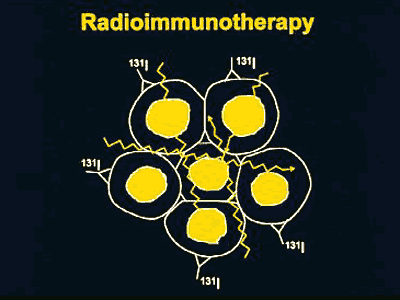According to a recent study published in the July issue of The Journal of Nuclear Medicine, the use of 177Lu-DOTA-rituximab as a radioimmunotherapy results in a first rate of tumor response while using less radiation than present therapies.
The new treatment alternative for patients with relapsing follicular, mantle cell and other indolent B-cell lymphomas has been regarded as safe and viable by researchers examining the possiblity of a low energy beta-emitter radiopharmaceutical.
Non-Hodgkin lymphoma, which consists of follicular, mantle cell and other slow-growing B-cell lymphomas, is the most widespread cancer of the lymphatic system, which is a branch of the immune system.
"Twelve years ago, when we started the study, it seemed that radioimmunotherapy could be a highly interesting tool that was both easy for clinicians to use and well-tolerated in patients. It also was clear that the use of iodine radionuclides was inconvenient for handling and not practical for patients because of the need for prolonged in hospital days due to radiation protection measures," said lead author of the study, Andreas Lohri, MD.
"Radioimmunotherapy with 177Lu-DOTA-Rituximab: Final Results of a Phase I/II Study in 31 Patients with Relapsing Follicular, Mantle Cell, and Other Indolent B-Cell Lymphomas. Although 90Y ibritumomab tiuxetan - Zevalin - was introduced shortly after we started the study, we felt it was important to do clinical experiments with other radionuclides."
The promising study registered 31 patients with histologically confirmed relapsed or refractory CD20-positive B-cell lymphoma. All patients were administered an initial dose of 740 MBq/m2 body surface area of 177Lu-DOTA rituximab. Doses were increased in steps of 185 MBq/m2 over a limit of seven doses. Hematologic and nonhematologic toxicity was calculated weekly up until the 10th week, or until recovery from the lowest level of blood cell count. Imaging with whole body computed tomography (CT) and 18F-FDG positron emission tomography (PET) or 18F-FDG PET/CT was performed at baseline and at 8-12 weeks.
The maximum endured dose using 177Lu-DOTA rituximab was 1,665 MBq/m2. Toxicity was chiefly hematologic, with thrombocytopenia and leukopenia seen as the dose-limiting toxicities, and nonhematologic toxicity was inconsequential.
Clinical responses took place at all dose levels for patients with follicular (82 percent overall response rate) and mantle cell (21 percent response rate) lymphomas. With an average follow-up of up to seven years, the approximated average time of survival following radioimmunotherapy resulted in four years.
"With 177Lu-DOTA Rituximab we can essentially do CD20 imaging. At the moment, this may be academically interesting and could potentially be used in daily practice if compared to all forms of current PET imaging,” said Lohri.
Since the early 1970s, occurrence rate for non-Hodgkin lymphoma has nearly doubled as cited by the Lymphoma Research Foundation. According to the National Cancer Institute, an estimated 70,000 men and women will be diagnosed with non-Hodgkin lymphoma and 19,000 will die of the disease in 2013.











